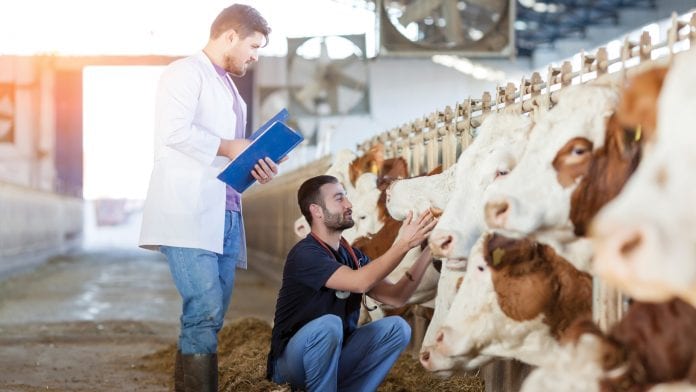
Gwyn Jones, chairman of RUMA, talks reducing unnecessary use of antimicrobials and medicines in agriculture and their dissemination into the environment.
Chairman of the Responsible Use of Medicines in Agriculture Alliance (RUMA), Gwyn Jones, sets out the great strides the UK livestock sector has made in its efforts to reduce antibiotic use.
Since 1997 the Responsible Use of Medicines in Agriculture (RUMA) Alliance1 has been guiding the UK livestock sectors on scientific best practice in use of animal medicines. As an alliance of food and farming organisations spanning all sectors and interests in the supply chain – from animal welfare charities and training organisations to retailers, veterinary surgeons and pharmaceutical companies – RUMA prides itself on providing science-based advice.
Using specialist veterinary input, it developed a comprehensive range of guidelines on responsible use of vaccines, anthelmintics, anti-parasiticides and antibiotics which have become the blueprint for the industry.
This gave British farmers and veterinary surgeons a picture of what ‘good’ looks like – how to use as little as possible but as much as necessary to treat and prevent disease that could otherwise cause pain or distress. This was most likely the reason the UK had comparatively low levels of antibiotic sales in farm animals compared with other major food-producing countries in the EU throughout 2014/201 Medicines in Agriculture.2
A reputational crisis
However, links between antibiotic use in farming and drug-resistant infections in humans started to be widely suggested in some media by the end of 2015, despite limited scientific evidence.
News had just broken of a new form of resistance to colistin, a drug of last resort, identified in China and present in both meat animals and people. An estimate that 70% of all antibiotics globally were used in farm animals started to be commonly applied to the UK, which was using half that. And it became a widespread assumption in the UK media that our farm animals were being ‘pumped full of antibiotics for growth promotion’ despite the practice being banned in Europe since 2006.3
The evidence of the link between use in farming and human health in the UK may have still been unclear, but the reputational crisis was unmistakeable.
With sector-led restrictions on colistin use already in place or in progress across many UK farm animal species, the Responsible Use of Medicines in Agriculture started serious urgent discussions with its members on how best to react to the wider challenges. The board took decisive action – to lead on the whole issue of antibiotic stewardship in UK farm animals so it could bring the farming industry into a much stronger position.
It was clear that significant reductions were possible: after launching a stewardship programme in 2011, the British poultry meat sector had already achieved a 44% reduction in antibiotic use.4
By the time the seminal O’Neill AMR review report ‘Tackling Drug-Resistant Infections Globally’ was published in May 2016,5 RUMA was ready to announce that the UK farming industry not only accepted that targets were necessary, but it would convene an expert group of farmers and veterinary surgeons to support each other in identifying targets suitable for each of their sectors. This would become RUMA’s Targets Task Force (TTF) and, in hindsight, was one of the most innovative steps our industry took.
The Targets Task Force
The TTF identified a leading farmer and leading vet from each of eight livestock sectors. The first meeting, scoping out the job that needed to be done and the boundaries and timescales, was in December 2016. Each representative farmer and vet pair would work together to gather baseline data on use, challenges and opportunities, then develop some draft targets which would be challenged by TTF peers in other sectors, then taken back to industry leaders in their own sector for further consultation. The group met bimonthly throughout 2017 and produced some very unexpected benefits.
Those involved became bolder and more confident as they had the backing of their colleagues in the group…
Want to know more about the TTF? Intrigued to discover what is specifically happening on-farm to achieve results? Curious about what else can be done?
Stay tuned for more, as the rest of this article will appear in issue 8 of Health Europa Quarterly, which will be published in February 2019.
References
- www.ruma.org.uk
- Joint Interagency Antimicrobial Consumption and Resistance. Analysis (JIACRA) Report. European Centre for Disease Prevention and Control, Jul 2017 https://www.ema.europa.eu/documents/report/ecdc/efsa/ema-second-joint-report-integrated-analysis-consumption-antimicrobial-agents-occurrence_en.pdf
- Ban on antibiotics as growth promoters in animal feed enters into effect. European Commission, December 2005 http://europa.eu/rapid/press-release_IP-05-1687_en.htm
- British Poultry Sector reduces antibiotic use by 44%. British Poultry Council, July 2016 https://www.britishpoultry.org.uk/british-poultry-sector-reduces-antibiotic-use-by-44/
- www.amr-review.org
Gwyn Jones
Chairman
Responsible Use of Medicines in Agriculture (RUMA) Alliance
Tweet @RUMA_UK
www.ruma.org.uk










